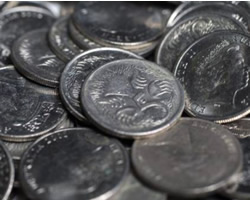Kristian Silva* says the Royal Australian Mint expects the rise of contactless payments will eventually see lowly silver coins phased out of circulation.
 The head of Australia’s national mint has predicted the “graceful death” of 5 and 10 cent coins within the next decade, leaving the 20¢ coin as the lowest form of circulating currency.
The head of Australia’s national mint has predicted the “graceful death” of 5 and 10 cent coins within the next decade, leaving the 20¢ coin as the lowest form of circulating currency.
Royal Australian Mint Chief Executive, Ross MacDiarmid said demand for coinage had dropped by about 55 per cent in the past five years, and most of that had been for silver coins.
“We’ve worked on the basis that somewhere in the next five to 10 years the 5¢ coin will probably just cease to be used,” Mr MacDiarmid said.
“We think that 10¢ will have a similar trajectory.”
“Retailers more than likely would be the ones that would stimulate a decline in the demand for 5¢ pieces because if you rounded up to 10 [cents] there’s not really much need for a five.”
Rising inflation, coupled with the growth of online and contactless payments, is rendering the lowly silvers obsolete, despite their place as a mainstay in café tip jars, charity tins, and school canteens.
Mr MacDiarmid expected that much like the old 1¢ and 2¢ coins, which were phased out in the 1990s, the Mint will eventually stop producing 5¢ and 10¢ coins.
He believed the outgoing currency would not be demonetised, meaning shops would still have the option to accept the outdated denominations and citizens could return the coins to banks and receive compensation.
The 5¢ and 10¢ coins were introduced in 1966 as part of Australia’s conversion to decimal currency.
Both reached their production peak in 2006, when a combined 463 million pieces were minted.
By the 2018 calendar year, that figure had dropped to 27 million.
Is the 50¢ coin next to go?
Mr MacDiarmid acknowledged the 50¢ coin was unpopular with many in the community, particularly those who were unable to use it for vending machines.
The large, 12-sided silver has been in its current form since 1969, and several million continue to be minted each year.
“We are monitoring its use in circulation to see whether there’s a need somewhere in the future for a different 50¢ piece to be produced,” Mr MacDiarmid said.
“It’s not something we’ve necessarily raised with the Government but it’s something that perhaps could be raised in the future.”
One strength of the 50¢ piece is its large face, making it perfect for limited editions or collectable coins.
“It can depict an image in a way that some of the other coins can’t,” Mr MacDiarmid said.
Mr MacDiarmid said there were currently about 4 billion coins in circulation and about 15 billion had been minted since 1965.
Even when accounting for damaged coins or denominations withdrawn from circulation, billions remain unaccounted for.
“A lot of these coins do get lost,” he said.
“They get taken overseas with tourists or they’ll get lost down the back of the seats.”
In the 2018–19 financial year, the Mint produced 111 million coins with about a quarter for countries in the Pacific.
Mr MacDiarmid said some sections of the community remained loyal users of cash and coins, including the elderly, students, and people on low incomes.
* Kristian Silva is the features reporter for ABC Radio Melbourne. He tweets at @kristian_silva.
This article first appeared at www.abc.net.au/news.




